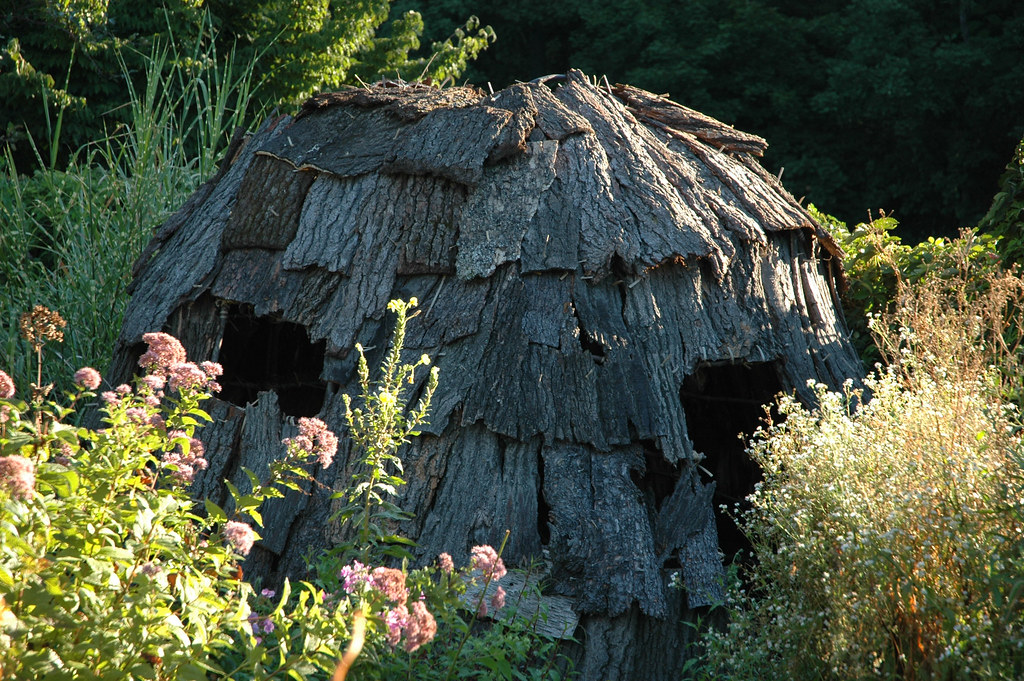Plan Your Weekend: Lenape Life
Posted in Learning Experiences, Programs and Events on September 26 2008, by Plant Talk
Indian Summer at the Howell Family Garden
 Annie Novak is coordinator of the Children’s Gardening Program.
Annie Novak is coordinator of the Children’s Gardening Program.
 Two years ago, two men named Eric built a second home. It wasn’t a vacation spot nor was it particularly accommodating for men of their height. At first, the only inhabitants were chipmunks, squirrels, and the occasional investigatory rabbit.
Two years ago, two men named Eric built a second home. It wasn’t a vacation spot nor was it particularly accommodating for men of their height. At first, the only inhabitants were chipmunks, squirrels, and the occasional investigatory rabbit.
Soon, however, the house was full of noise. Children busily explored the low dome of the interior and peered out the window into the neighboring garden. So it was that in 2006, the wigwam that Eric Wright and Eric Sanderson built became the latest structural addition to the Ruth Rea Howell Family Garden.
Although it’s the first wigwam in The New York Botanical Garden, it is by no means the first to grace the cliffs along the Bronx River’s shore. As Sanderson is quick to explain, for the 5,000 years before New York City’s skyline dominated the Hudson, Native Americans lived along the river system. Known as the Lenape, they inhabited the large area they called Leanapehoking all throughout New York and New Jersey, as far as the Delaware Water Gap.
Learn more about the wigwam in the Family Garden after the jump.
Check out Saturday’s programming
Check out Sunday’s programming
Sanderson and Wright’s history is more recent. The two met as volunteers at the Howell Family Garden. Avid local historians both, together they created the Lenape Garden, focusing on the traditional Three Sisters trio of corn, squash, and beans. In keeping with the Lenape diet, the Erics planted amaranth grain and revitalized the Family Garden’s raspberry bushes. It was Sanderson’s involvement in the Mannahatta Project and re-imagining New York that sparked the more ambitious project of a Lenape house. “Neither of us knew how to make a wigwam, so we did some research. We found a Web site and followed the instructions,” Sanderson explained. Constructed of saplings, bark, and straps of pine lashings, the two men deviated in the wigwam’s authenticity only when it came to drilling holes. “The Lenape would have used a bone or a shark tooth,” Sanderson said, “But that would have taken a long time. We used a drill.”
 Sanderson is one of the few New Yorkers who can stand within sound range of the traffic on the Bronx River Parkway and hear only the rush of water in the Bronx River nearby. With the wigwam, Sanderson sought to take visitors and families to the Family Garden back in time, to a period when a family would happily live in a space 10 feet across. “New Yorkers complain about how small their apartments are,” Sanderson laughs. “The Lenape just had a different sense of privacy.”
Sanderson is one of the few New Yorkers who can stand within sound range of the traffic on the Bronx River Parkway and hear only the rush of water in the Bronx River nearby. With the wigwam, Sanderson sought to take visitors and families to the Family Garden back in time, to a period when a family would happily live in a space 10 feet across. “New Yorkers complain about how small their apartments are,” Sanderson laughs. “The Lenape just had a different sense of privacy.”
Just like people today, the Lenape had to make a living. Much of their food came from the forest and the water. They foraged among New York state native plants and trees for food such as American chestnuts, hickory nuts, and beech nuts as well as fruit such as blackberries, grapes, cranberries, elderberries, and strawberries. The Lenape also hunted deer and elk as well as smaller game such as turtles, frogs, and rabbits. In the springtime, Sanderson explained, the Lenape turned to the waters of the river and the bay to catch fish and oysters.
As I write, much of the little wigwam is hidden by a growth of vines crawling up its bark dome. In the Lenape story of creation, the world is carried on the back of turtle. As our young visitors spot the wigwam in the Meadow, they bend low to enter the cool shell of its interior. Their voices quiet, drawn in by the wigwam’s cocooning qualities. I find it comforting to see the parallel between a world balanced on the dome of a careful creature’s back and the protective coziness of a wigwam built to teach and shelter children. From its interior looking out into the garden, it’s easy to come one step closer to the same lens Sanderson uses to see the Bronx, a New York home to hawks and hawthorn trees, and a people that enjoy plants as much as we do at the Family Garden.
It’s fitting that come September, amid the skittish heat and cold of a proverbial Indian summer, the Family Garden’s public afternoon programs focuses on a celebration of New York’s indigenous Lenape culture. This month, visitors can plant their own corn seed or help build the low wall of a palisade surrounding the Three Sisters garden of tall corn, low-lying squash, and climbing beans. Another popular craft is making corn husk dolls. Modeled after traditional Lenape dolls, at the Family Garden we fudge a bit by using rubber bands.
Lenape Life runs through September 28, from 1 to 5:30 p.m.

